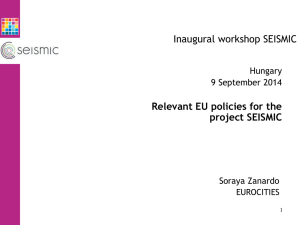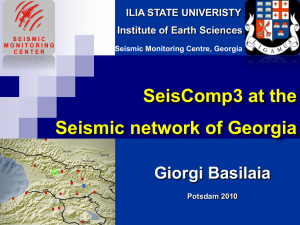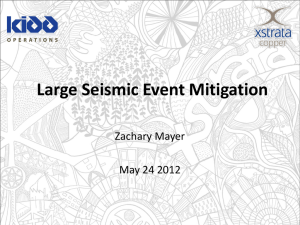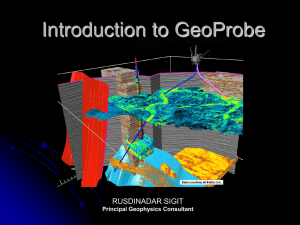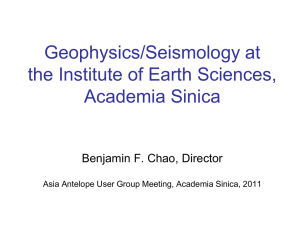ORFEUS VEBSN
advertisement
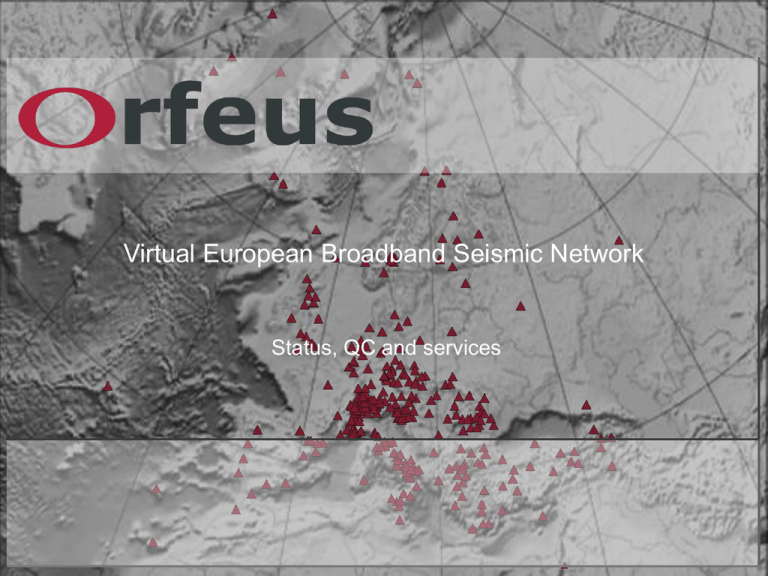
Virtual European Broadband Seismic Network Status, QC and services Orfeus data center ORFEUS Data Center – mission The primary purpose of the ORFEUS Data Center (ODC) is to collect and archive high quality seismic broadband waveform data from European and Mediterranean organizations, and to give open and rapid access to the data by the scientific community. The ODC can fulfill this mission only in strong cooperation with seismic observatories, seismic network operators and end users from the scientific community. How it started… 30 stations Jan 1987 Vebsn - mapview 400 stations Mar 2010 502 stations total Vebsn – contributors AI - Antarctic Seismographic Argentinean Italian Net BE - Belgian Seismic Network BN - UK-Net BS - National Network of Bulgaria BW - BayernNetz CA - Catalan Seismic Network CH - Switzerland Seismological Network CR - Croatian Seismograph Network CZ - Czech Seismic Network DK - Danish Seismological Network DZ - CRAAG, Algeria EI - Irish Regional Digital Seismic Network ES - SPANISH DIGITAL SEISMIC NETWORK FN - Northen Finland Seismological Network FR - French Broadband Seismological Network G - GEOSCOPE GB - Great Britain Seismograph Network GE - GEOFON GR - German Regional Seismic Network GU – University of Genua, Italy HE - Finnish National Seismic Network (HEL) HF - Swedish Seismic Array Network HL - National Observatory of Athens Digital Broadband HP - University of Patras HT - Aristotle University of Thessaloniki Seismology HU – Hungarian Seismological Network IG - Instituto Andaluz de Geofisica II - IRIS/IDA Network IP - Instituto Superior Tecnico Broadband Seismic Net IS - Israel National Seismic Network IU - IRIS/USGS Network IV - Italian National Seismic Network KO - Kandilli Observatory MN - MEDNET NA - Netherlands Antilles Seismic Network NI – North-East Italy BB network (OGS, Uni. Trieste) NL - Netherlands Seismic Network NO - Norwegian Seismic Array Network NR - NARS Array NS - Norwegian National Seismic Network OE - Austrian Seismic Network PL - Polish Seismological Network PM - Portuguese National Seismograph Network RO - Romanian Seismic Network SJ - Serbian National Network SK - Slovak National Seismic Network SL - Slovenia Seismic Network SS - SINGLE STATION (Ebro Observatory) SX - Saxon network / Leipzig TT - Seismic Network of Tunisia, Institut National de la Meteorologie TU - National Earthquake Observ. Netw., Ankara, Turkey UP - University of Uppsala Network VI - Icelandic National Digital Seismographic Network over 50 networks Vebsn - data Data-flow over 1650 channels flowing in per day resulting in a “size per day” of around 7 Gb mainly slink2orb and orb2orb Frequency-range ranging from very broad band (0.1 Hz) up to high frequency channels (125 Hz) Additional sensor 30 accelerometric stations (120 Hz) from the Swiss network Vebsn – realtime status Current status, up to channel level QC – quality control PQLX near real time calculation of Probability Density Functions PSD near real time calculation of Power Spectral Densities Response info graphic representation of the metadata Mag/Time residuals histograms providing information on the performance of stations on event parameters QC – PQLX Old situation calculations on all incoming traces. Currently 1 day takes approximately 10 hours (1 cpu) New situation new 4 quad core server, running pqlx on 8 cpu’s I day takes approximately 1-1.5 hours backwards calculations for archive data 2010, currently somewhere in 2006. QC – PSD Power Spectral Density PSD of the background noise as function of time, for selected frequencies Daily update, plot covers 1 year QC – response info System response overall system responses are visualized in graphical form from the dataless SEED volumes History complete record of changes in time QC – mag/time residuals Antelope processing provides location and magnitudes (automatic) Histograms station magnitude with respect to network magnitude time residual between calculated and measured arrival time Services Email based data request services, like NetDC, BreqFast and autodrm (email based) Orfeus Web Interface step by step interface for requesting event,miniseed,dataless and fullseed data Web-services data-retrieval client using webservices of NERIES portal (in development) Seismic data portal (NERIES) web portal, going into production stage April 2010 Neries seismic portal “Waveform Explorer” Remote Portlet Multi Modal waveform requests, Event or Time Modes “Event Explorer” Jetspeed Portlet Seismic Events Selection User Events Cart Ws Neries seismic portal Request ID as URI. The dynamically generated dataset (Event`s parameters and the waveform ) can be stored in the SMI RDF Model User provided rate Dataset user description Seisgram2K visualization Neries seismic portal http://www.seismicportal.eu

